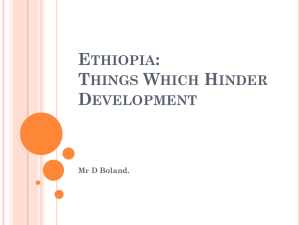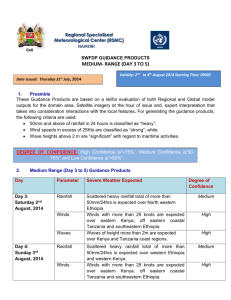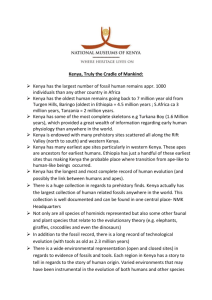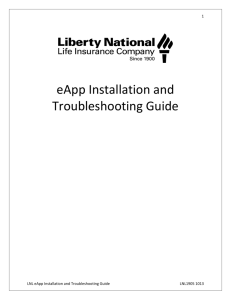PROJECT INFORMATION DOCUMENT (PID)
advertisement
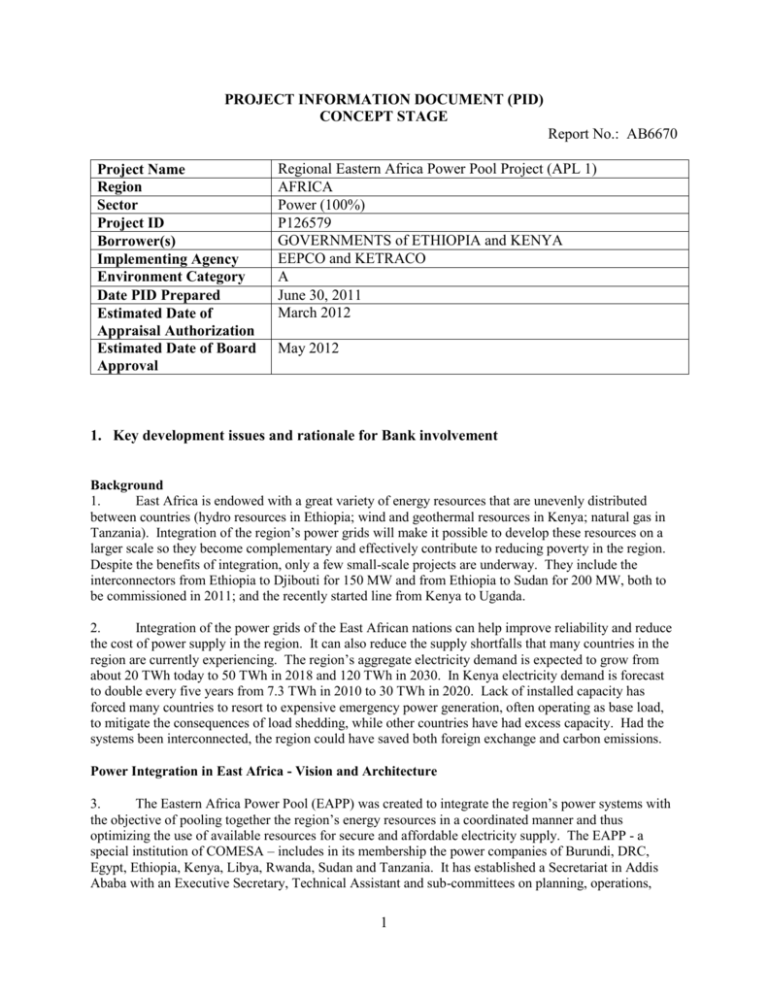
PROJECT INFORMATION DOCUMENT (PID) CONCEPT STAGE Report No.: AB6670 Project Name Region Sector Project ID Borrower(s) Implementing Agency Environment Category Date PID Prepared Estimated Date of Appraisal Authorization Estimated Date of Board Approval Regional Eastern Africa Power Pool Project (APL 1) AFRICA Power (100%) P126579 GOVERNMENTS of ETHIOPIA and KENYA EEPCO and KETRACO A June 30, 2011 March 2012 May 2012 1. Key development issues and rationale for Bank involvement Background 1. East Africa is endowed with a great variety of energy resources that are unevenly distributed between countries (hydro resources in Ethiopia; wind and geothermal resources in Kenya; natural gas in Tanzania). Integration of the region’s power grids will make it possible to develop these resources on a larger scale so they become complementary and effectively contribute to reducing poverty in the region. Despite the benefits of integration, only a few small-scale projects are underway. They include the interconnectors from Ethiopia to Djibouti for 150 MW and from Ethiopia to Sudan for 200 MW, both to be commissioned in 2011; and the recently started line from Kenya to Uganda. 2. Integration of the power grids of the East African nations can help improve reliability and reduce the cost of power supply in the region. It can also reduce the supply shortfalls that many countries in the region are currently experiencing. The region’s aggregate electricity demand is expected to grow from about 20 TWh today to 50 TWh in 2018 and 120 TWh in 2030. In Kenya electricity demand is forecast to double every five years from 7.3 TWh in 2010 to 30 TWh in 2020. Lack of installed capacity has forced many countries to resort to expensive emergency power generation, often operating as base load, to mitigate the consequences of load shedding, while other countries have had excess capacity. Had the systems been interconnected, the region could have saved both foreign exchange and carbon emissions. Power Integration in East Africa - Vision and Architecture 3. The Eastern Africa Power Pool (EAPP) was created to integrate the region’s power systems with the objective of pooling together the region’s energy resources in a coordinated manner and thus optimizing the use of available resources for secure and affordable electricity supply. The EAPP - a special institution of COMESA – includes in its membership the power companies of Burundi, DRC, Egypt, Ethiopia, Kenya, Libya, Rwanda, Sudan and Tanzania. It has established a Secretariat in Addis Ababa with an Executive Secretary, Technical Assistant and sub-committees on planning, operations, 1 environment etc. led by executives of the member utility companies. With funding from the AfDB, the European Commission, Government of Norway and the US, the EAPP has prepared a Regional Power Master Plan and developed a Grid Code to govern the operations of the regional interconnected electricity network. 4. The EAPP transmission backbone will be built up gradually over a 30-year period through the construction of a network of transmission lines that will connect eight countries in East Africa. The estimated cost of these investments is US$4.7 billion, based on two ongoing least-cost expansion plan studies being carried out by the EAPP Secretariat and by the Nile Basin Initiative. 5. IDA support to building the EAPP backbone is proposed to be structured as a horizontal Adaptable Program Loan (APL), consisting of five major transmission projects. These projects represent a time-slice of EAPP’s 10-year least-cost expansion plan and account for about 25 percent of the total investment needs of the 10-year plan. The projects are the following: Ethiopia-Kenya (the Eastern Corridor) Tanzania-Kenya Tanzania-Rwanda Tanzania-Burundi Tanzania-Uganda 6. IDA selected these projects for support based on their importance for the region, urgency in terms of market demand, and level of preparedness. The selection criteria also included a measure of robustness, that is, how beneficial the transmission line is across a variety of scenarios and assumptions. The above list of projects is indicative. The optimal sequence may change because of various factors, e.g. demand growth in the countries. The APL program will therefore develop specific criteria for selecting the individual projects that IDA will support. Eastern Corridor (Kenya – Ethiopia Interconnector) – the Anchor Project for the Eastern African Power Pool 7. Connecting the electric systems of these two countries will allow surplus electricity in Ethiopia to be exported to satisfy rapidly growing electricity demand in Kenya. It is also likely that in time, electricity will flow from south to north. The proposal is to build a 1,100 km long transmission line that will connect the two power systems via a 500 kV DC link. This link will enable energy from the Ethiopian grid to flow southward to Kenya and farther to its neighboring countries once they have connected to the Kenyan grid. In the medium term, Kenya will become a central node along this corridor, facilitating electricity trade among its neighbors as a result of differences in the cost of supply in the countries. 8. The Eastern Corridor will provide a large percentage of the energy needs of Kenya, Uganda and its neighbors. However, these countries cannot solely rely on hydro imports from Ethiopia (whose production can be volatile) and on a single physical corridor to meet their market needs. Therefore, Kenya is scaling-up the development of its geothermal and wind resources to provide a secure mix of power generation options for the region. 2 Rationale for the Bank’s involvement 9. The Bank involvement in the EAPP interconnection program and the Eastern Corridor project is consistent with the Africa Region’s Strategy for knowledge sharing, partnership building and catalyzing financing for the client countries. 10. The Bank’s participation can help rationalize and coordinate the multiple and sometimes conflicting power trade initiatives being discussed in the region by helping the countries prioritize key generation and transmission investments. Over the long run, those are not mutually exclusive. The Bank’s engagement will help ensure that the multiple projects are developed in a sensible sequence by supporting mobilization of funds from multiple donors in a timely and efficient manner, therefore maximizing capacity utilization of the assets. 11. By improving supply of reliable and clean energy among East African nations, the Program will contribute to boost competitiveness, employment and resilience in East Africa, as emphasized by the Bank’s Africa Region Strategy. The program is also perfectly aligned with the objective of climate change mitigation and adaptation. On the mitigation side, the EAPP backbone will enable the displacement or avoidance of 7-8 GW in fossil fuel generation in the region. On the adaptation side the interconnection of electric systems with hydro generation located in different basins will help reduce the impact of climate variability, therefore working as a hedge to mitigate hydrological risk. 12. The proposed program of investments is consistent with the criteria of engagement and selectivity set out in the Regional Integration Assistance Strategy (RIAS)1 and with the objectives of the Country Partnership and Assistance Strategies (CPS and CAS) for Ethiopia, Kenya, and Tanzania. The proposed program of investments addresses RIAS’s priorities to improve access to clean energy and improve power supply reliability. The program also meets the criteria for what constitutes regional projects as it: (i) involves more than three countries (ii) will produce economic benefits that will spill over to neighboring countries, since the investments underpin economic growth in the countries where they take place; and (iii) it involves evidence of regional ownership and commitment by the participating countries and provides a platform for policy harmonization in power sector development. The objective of advancing the interconnection of the power systems of the East African countries is recognized in the CPS of Kenya, Ethiopia and Tanzania, just to mention a few. 13. Bank involvement will promote environmental and social mitigation and monitoring as it will require the preparation and implementation of ESIAs and RAPs according to Bank standards. 2. Proposed objectives 14. Program Objective: To improve the reliability of electricity supply in the East Africa region. 15. Project Objective (APL1 - Eastern Corridor): (a) transfer electricity between Ethiopia and Kenya; and (b) facilitate the integration of the power grids of the East African countries. 3. Preliminary description Eastern Corridor (Ethiopia-Kenya Interconnection) 16. 1 The Project has three components: Regional Integration Assistance Strategy, IDA and IBRD, April 2008. 3 Component 1. Construction of a 1,100 km transmission line, with 2,000 MW of transfer capacity, to connect the power grids of Ethiopia and Kenya (US$820 million) 17. This component will construct the necessary transmission lines and substations in Kenya and Ethiopia to provide a strong electrical link between their power systems and to serve as an anchor to the development of the Eastern Africa Power Pool (EAPP). Component 2. Institutional Capacity Building (US$20 million) 18. This component will provide capacity building and technical assistance to the EAPP Secretariat and the transmission companies of Kenya and Ethiopia primarily in generation and transmission planning, energy dispatching, operational procedures for power trading and environmental management. The contents of the capacity building will be finalized during preparation in consultation with the countries concerned, the EAPP Secretariat, the transmission companies and Development Partners. The overall objective is to grow the human capacities needed for the development of a sound regional power market. Component 3. Environmental and Social Mitigation (US$60 million) 19. This component will finance the necessary activities to mitigate the environmental and social impacts of the project, including the implementation of an Environmental and Social Management Plan and a Resettlement Action Plan for the affected areas and mitigation measures to offset possible damage on the environment. The details of this component will be developed after the ESIA/RAP studies are completed. 4. Safeguard policies that might apply Safeguard Policies that might be Triggered by the Project Environmental Assessment (OP/BP 4.01) Natural Habitats (OP/BP 4.04) Forests (OP/BP 4.36) Pest Management (OP 4.09) Physical Cultural Resources (OP/BP 4.11) Indigenous Peoples (OP/BP 4.10) Involuntary Resettlement (OP/BP 4.12) Safety of Dams (OP/BP 4.37) Projects on International Waterways (OP/BP 7.50) Projects in Disputed Areas (OP/BP 7.60)* * Yes X X No TBD X X X X X X X X By supporting the proposed project, the Bank does not intend to prejudice the final determination of the parties' claims on the disputed areas 4 5. Tentative financing plan Source: BORROWERS/RECIPIENTS International Development Association (IDA) African Development Bank (AfDB) European Investment Bank (EIB) French Development Agency (AFD) Total ($m.) 40 370 300 70 120 900 6. Contact point Contact: Title: Tel: Email: 7. Ms. Paivi Koljonen Lead Energy Specialist (202) 473-2606 pkoljonen@worldbank.org For more information contact The InfoShop The World Bank 1818 H Street, NW Washington, D.C. 20433 Telephone: (202) 458-4500 Fax: (202) 522-1500 Web: http://www.worldbank.org/infoshop wb10286/ P:\ETHIOPIA\WUE\EAPP\PCN\EAPP-PID-Concept-Disclosed-July-26-2011.doc / 7/26/2011 5:10:00 PM 5
